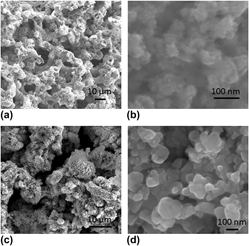Published online by Cambridge University Press: 17 June 2013

Nanocasting into silica templates for preparation of mesoporous materials has up to now been limited to those metal oxides and metals that can withstand the harsh silica etching processes currently used. Two new methods of removing the silica template are reported, either by dissolving the silica in methanolic base or by dissolution in aqueous base under an external potential. The utility of these methods is demonstrated in the synthesis of hierarchically porous zinc oxide, nickel oxide, and copper monoliths that would dissolve or react using other template removal methods. The successful etching of monolithic zinc oxide using methanolic base etching can be explained by the reduced solubility of zinc oxide in methanol compared with an aqueous base, while it also reduces the formation of hydroxides when etching the nickel oxide and copper monoliths. Alternatively, the formation of highly soluble copper oxide/hydroxide can be avoided by holding the copper monolith at a sufficiently negative potential while etching with an aqueous base.